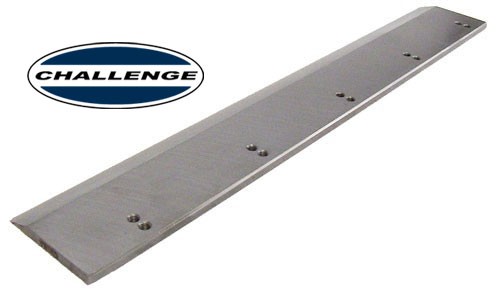
KNIFE SAFETY! Cutter knives are DANGEROUS!!! They are heavy and very sharp, even after use. Keep the edge away from your body and keep the area clear of others when handling knives. Never touch the cutting edge! To prevent personal injury and damage to the knife, always keep knives in their holders with screws tightened. You are aware of the dangers, but others may not be. Never attempt to hone, polish, or service the knife in any way. Failure to follow safety procedures may result in severe lacerations or dismemberment.
Cutter knife blade life, or the time between sharpening, can be affected by many factors. One important factor is the type of paper being cut. Abrasive paper, such as recycled paper, soft paper such as newsprint paper, and bound books can all significantly shorten cutter knife blade life. Also, if the cutter knife depth is set too deep, the knife will cut too deep into the cutting stick and can dull the cutter knife blade.

A paper cutter knife can last anywhere between 2,000 and 5,000 cuts before it needs to be sharpened. Cutting soft paper (such as newsprint paper) or paper with high post-consumer recycled content can cause the knife to need sharpening after only 2,000 to 3,000 cuts. Cutting pure paper, such as bond paper with no recycled content, or hard paper can allow the knife to be used for as many as 5,000 cuts before it needs to be sharpened. In all cases, the operator continually check the quality of the cut to determine when the knife blade needs to be sharpened.
Indications of a dull cutting knife:
- Knife hesitates or stalls while making a cut
- Sheets are not all cut the same length (Usually the top few sheets are longer than the rest of the sheets – this is sometimes called “draw”)
- Cut marks appear on the cut face of the paper
- The profile of the cut (side view) is not perpendicular to the table
- The cut does not appear straight when viewed from the top
- The knife makes a “rougher” sound as it passes through paper
- Nicks are visible on the cutting edge of the knife
1. Cutting Stick
A worn cutting stick can affect the cut quality of the bottom sheets. When this happens, the cut stick can be rotated. Usually, the stick should be rotated one or two times between knife sharpening.
There are 8 possible cut stick positions. The stick can be rotated 4 times, and then turned end to end, and rotated 4 times again.
2. Bevel Angle
Challenge recommends that bevel angles for knives be in the range of 2° to 23°. In general, a 21° bevel angle will provide better cut quality when cutting soft paper (such as newsprint), recycled paper, or bound books. However, 21° angle knives can become dull sooner than 23° knives, which results in shorter knife blade life. A knife with a 23° bevel angle, on the other hand, will not dull as easily, and can provide satisfactory results when cutting most types of paper.
3. Helpful Suggestions
It may be beneficial to purchase more than one set of knives: one set beveled at 21° and the other at 23°. Note: A set consists of 3 knives: one in the machine, one as a back up, and one at the grinder.
If the machine seems to strain but the cut quality is still good, reduce the pile height. You may also carefully apply glycerin to the bevel when cutting hard, coated paper. Tie a cloth to the end of a stick; dip the stick in glycerin, and apply. Never apply by hand! In lieu of glycerin you may lightly rub white bar soap along the bevel. Lubrication will prolong the life of your machine and reduce maintenance.
4. Cutter Knife Care
- To prevent corrosion, knives are coated with light oil and should be REMOVED WITH CARE
- While removing or installing a knife, be careful not to allow the edge to bump against the machine; nicks will result
- If a bolt is damaged, replace it:
- Always keep knife bolts securely tightened
- Always use heavy-duty knife bolt washers provided by Challenge
- Failure to do so could result in scratching or marring of the clamp face
- Store knives in a dry environment to prevent corrosion
- Never attempt to service a knife in any way
Taking care of your equipment is an important part of running a successful business. Paper cutters are hard working machines and a nice clean knife will help lighten the load on the drive mechanism. It will also help keep a nice clean cut edge without any frayed paper fibers leading to a high quality output. Take care of your cutter using the tips in this article and if your cutter is past it’s usable life consider talking to our sales team for a replacement.

